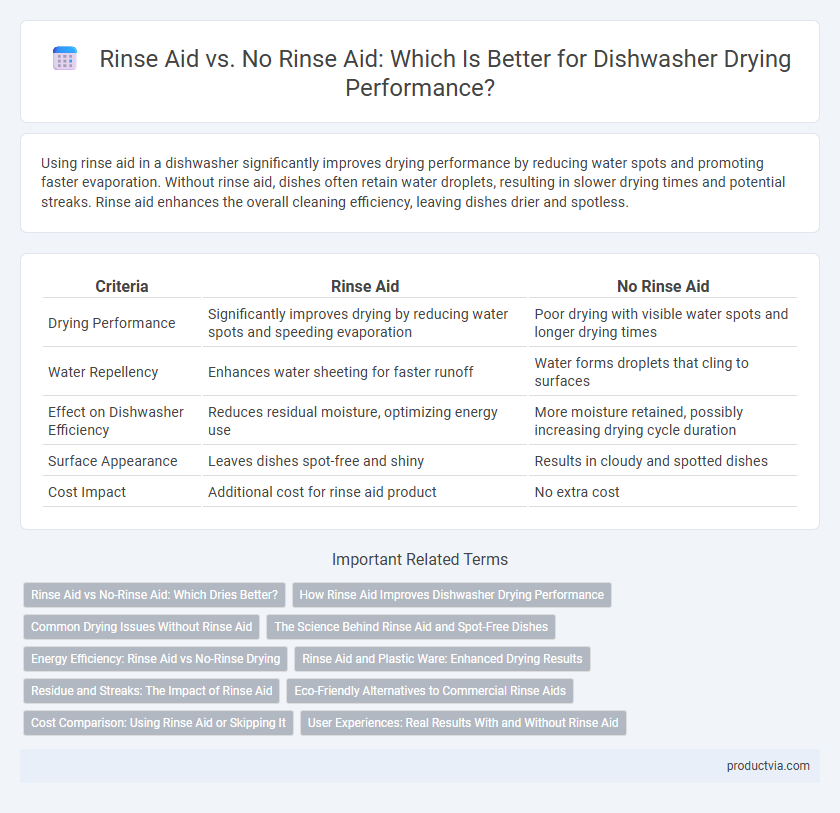Using rinse aid in a dishwasher significantly improves drying performance by reducing water spots and promoting faster evaporation. Without rinse aid, dishes often retain water droplets, resulting in slower drying times and potential streaks. Rinse aid enhances the overall cleaning efficiency, leaving dishes drier and spotless.
Table of Comparison
| Criteria | Rinse Aid | No Rinse Aid |
|---|---|---|
| Drying Performance | Significantly improves drying by reducing water spots and speeding evaporation | Poor drying with visible water spots and longer drying times |
| Water Repellency | Enhances water sheeting for faster runoff | Water forms droplets that cling to surfaces |
| Effect on Dishwasher Efficiency | Reduces residual moisture, optimizing energy use | More moisture retained, possibly increasing drying cycle duration |
| Surface Appearance | Leaves dishes spot-free and shiny | Results in cloudy and spotted dishes |
| Cost Impact | Additional cost for rinse aid product | No extra cost |
Rinse Aid vs No-Rinse Aid: Which Dries Better?
Rinse aid significantly improves drying performance in dishwashers by reducing water spots and accelerating water sheeting off dishes, resulting in faster and more thorough drying. Without rinse aid, dishes often retain water droplets that prolong drying times and cause streaks or spots. Studies show that using rinse aid can cut drying time by up to 30% compared to no-rinse aid cycles, enhancing both efficiency and cleanliness.
How Rinse Aid Improves Dishwasher Drying Performance
Rinse aid enhances dishwasher drying performance by reducing water surface tension, which allows water to sheet off dishes more effectively and prevents water spots and streaks. This improved sheeting action promotes faster evaporation during the drying cycle, resulting in drier dishes without the need for additional drying time. Using rinse aid also supports better performance in hard water areas by minimizing mineral deposits that can hinder drying efficiency.
Common Drying Issues Without Rinse Aid
Common drying issues without rinse aid include water spots, streaks, and slow drying times due to increased surface tension on dishes. Without rinse aid, residual water clings to surfaces, leading to uneven drying and potential mineral deposits. Using rinse aid enhances water sheeting, promoting faster evaporation and leaving dishes spotless and dry.
The Science Behind Rinse Aid and Spot-Free Dishes
Rinse aid enhances drying performance in dishwashers by reducing water's surface tension, allowing water to sheet off dishes rather than forming droplets that cause spots and streaks. Without rinse aid, residual water can evaporate unevenly, leading to dried-on mineral deposits and cloudy marks, especially in hard water areas. The surfactant properties of rinse aid promote spot-free, glossy dishes by improving water drainage and reducing the formation of mineral spots during the final rinse cycle.
Energy Efficiency: Rinse Aid vs No-Rinse Drying
Rinse aid significantly improves drying performance by reducing water spots and promoting faster evaporation, which in turn lowers the dishwasher's energy consumption. Without rinse aid, dishes often retain water droplets requiring longer drying cycles or manual drying, increasing overall energy use. Utilizing rinse aid optimizes energy efficiency by enabling shorter drying phases and minimizing heat and electricity demand.
Rinse Aid and Plastic Ware: Enhanced Drying Results
Rinse aid significantly improves drying performance, especially for plastic ware, by reducing water surface tension and preventing droplets from clinging to surfaces. Without rinse aid, plastic items often retain water spots and take longer to dry due to their hydrophobic properties. Using rinse aid ensures faster, streak-free drying results, enhancing overall dishwasher efficiency.
Residue and Streaks: The Impact of Rinse Aid
Rinse aid significantly reduces residue and streaks on dishes by lowering the surface tension of water, allowing it to sheet off more effectively during the drying cycle. Without rinse aid, water droplets tend to cling to surfaces, leaving behind mineral deposits and streaks that impair drying performance. Using rinse aid improves overall cleanliness and enhances the visual appeal of dishes by minimizing water spots and promoting faster evaporation.
Eco-Friendly Alternatives to Commercial Rinse Aids
Eco-friendly alternatives to commercial rinse aids, such as white vinegar or citric acid, improve drying performance by reducing water spots and enhancing water sheeting during the rinse cycle. These natural options minimize chemical usage and environmental impact while maintaining effective drying results. Using no rinse aid often leads to slower drying and more residue, making eco-friendly substitutes a sustainable choice for both performance and the planet.
Cost Comparison: Using Rinse Aid or Skipping It
Using rinse aid in dishwashers typically increases upfront costs due to the need to regularly purchase the specialized liquid, but it enhances drying performance by preventing water spots and improving water sheeting on dishes. Skipping rinse aid reduces ongoing expenses but can result in longer drying times and less effective water drainage, potentially requiring energy-intensive additional drying cycles. Over time, the cost savings from avoiding rinse aid may be offset by increased energy consumption and potential residue buildup requiring more frequent maintenance.
User Experiences: Real Results With and Without Rinse Aid
Users consistently report improved drying performance when using rinse aid, noting fewer water spots and faster drying times on dishes and glassware. Without rinse aid, many experience stubborn water droplets and longer drying cycles, especially on plastic and delicate items. Real-world feedback highlights that rinse aid optimizes surface tension, enabling more efficient water sheeting and enhanced overall drying results.
Rinse aid vs No-rinse aid for drying performance Infographic

 productvia.com
productvia.com